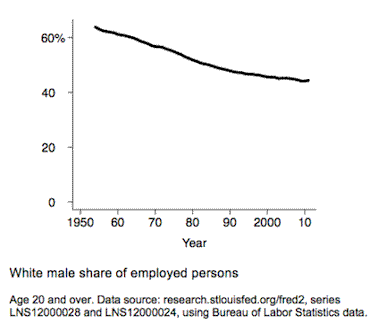From the mid-1940s through the mid-1970s, inflation-adjusted wages for Americans in the middle and below rose in sync with the economy. Since then, the median wage has barely budged. Steve Landsburg suggests that worry about this is misplaced, because what looks like wage stagnation actually is an artifact of a compositional shift in our labor force: “There’s been a great influx of lower income groups — women and nonwhites — into the workforce. This creates the illusion that nobody’s progressing when in fact everybody’s progressing.”
It’s true that employment of women and nonwhites has increased relative to that of white males. But that didn’t begin in the late 1970s. It’s been going on for a long time. Here is the trend in the white male share of total employment since the early 1950s:

A compositional shift in employment isn’t what distinguishes the era of wage stagnation from the earlier period of rising wages.
Disclaimer: This page contains affiliate links. If you choose to make a purchase after clicking a link, we may receive a commission at no additional cost to you. Thank you for your support!


Leave a Reply